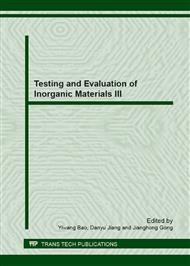[1]
J. Qiu, R. Shen, X. Fu, D. Yan, Mechanical Property Loss of Hot-Pressed Si3N4 under Thermal Fatigue Conditions, J. Inorg. Mater. 6 (1991) 53-59 (in chinese).
Google Scholar
[2]
F. F. Lange, High-Temperature Strength Behavior of Hot-Pressed Si3N4: Evidence for subcritical Crack Growth, J. Am. Ceram. Soc. 57 (1974) 84-87.
DOI: 10.1111/j.1151-2916.1974.tb10819.x
Google Scholar
[3]
S. Shong, X. Ai, C. Huang, Study Development for Thermal Shock Resistance and Its Mechanisms of Ceramics, J. Ceram. 23 (2002) 233-237 (in Chinese).
Google Scholar
[4]
W. D. Kingery, Metal-ceramic interaction: Ⅳ, absolute measurement of metal-ceramic interfacial energy and interfacial adsorption of silicon from iron-silicon alloys, J. Am. Ceram. Soc. 37 (1954) 42-25.
DOI: 10.1111/j.1151-2916.1954.tb14002.x
Google Scholar
[5]
W. D. Kingery, Factors affecting thermal stress resistance of ceramic materials, J. Am. Ceram. Soc. 38 (1955) 3-15.
Google Scholar
[6]
D. P. H. Hasselman, Griffith Criterion and Thermal Shock Resistance of Single-Phase Versus Multiphase Brittle Ceramics, J. Am. Ceram. Soc. 52 (1969) 288-289.
DOI: 10.1111/j.1151-2916.1969.tb09188.x
Google Scholar
[7]
D. P. H. Hasselman, Approximate Theory of Thermal Stress Resistance of Brittle Ceramics Involving Creep, J. Am. Ceram. Soc. 50 (1967) 454-457.
DOI: 10.1111/j.1151-2916.1967.tb15160.x
Google Scholar
[8]
Y. Bao, Failure Behaviors and Lifetime Prediction of Al2O3, SiC and HP-Si3N4, J. China Ceram. Soc. 29 (2001) 21-25 (in Chinese).
Google Scholar
[9]
J. P. Singh, K. Niihara, D. P. H. Hasselman, Analysis of thermal fatigue behavior of brittle structural materials, J. Mater. Sci. 16 (1981) 2789-2797.
DOI: 10.1007/bf02402843
Google Scholar
[10]
N. Kamiya, O. Kamigato, Prediction of thermal fatigue life of ceramics, J. Mater. Sci. 14 (1979) 573-582.
Google Scholar
[11]
N. Kamiya, O. Kamigaito, Thermal fatigue life of ceramics under mechanical load, J. Mater. Sci. 17 (1982) 3149-3157.
DOI: 10.1007/bf01203477
Google Scholar
[12]
X. Ling, J. Shen, H. Lian, H. Sun, Testing Method Study on High Temperature Fatigue of Fine Ceramics, Phys. Testing Chem. Anal. Part A (Physical Testing). 23 (1996) 21-25 (in Chinese).
Google Scholar
[13]
J. Lv, Z. Zheng, Z. Jin, H. Ding, Indentation-Quench Method to Determine the Thermal Shock Resistance for Toughing Al2O3 Ceramic Matrix Composites, Phys. Testing Chem. Anal. Part A (Physical Testing). 39 (2003) 4-18 (in Chinese).
Google Scholar
[14]
S. Maensiri, S. G. Roberts, Thermal Shock Resistance of Sintered Alumina/Silicon Carbide Nanocomposites Evaluated by Indentation Techniques, J. Am. Ceram. Soc. 85 (2002) 1971-(1978).
DOI: 10.1111/j.1151-2916.2002.tb00390.x
Google Scholar
[15]
J. Qiu, R. Shen, X. Fu, Thermal Fatigue Behavior of Silicon Nitride Ceramics, J. China Ceram. Soc. 21 (1993) 188-192 (in Chinese).
Google Scholar
[16]
R. Geng, G. Shen, S. Liu, An Overview on the Development of Acoustic Emission Signal Processing and Analysis Technique, Nondestructive Testing. 24 (2002) 23-28 (in Chinese).
Google Scholar
[17]
M. Guo, J. Zhao, Monitoring Thermal-Shock Damage in Ceramic Materials by Means of Acoustic Emission, China Ceram. 37 (2001) 34-36 (in Chinese).
Google Scholar
[18]
S. Yan, M. Liu, Acoustic Emission Technique and Application, J. Xi'an Aerotech. College. 20 (2002) 64 (in Chinese).
Google Scholar
[19]
S. Momon, M. Moevus, N. Godin, M. R'Mili, P. Reynaud, G. Fantozzi, G. Fayolle, Acoustic emission and lifetime prediction during static fatigue tests on ceramic-matrix-composite at high temperature under air, Composites: Part A. 41 (2010) 913-918.
DOI: 10.1016/j.compositesa.2010.03.008
Google Scholar
[20]
T. Li, H. Du, S. Tang, J. Chen, Acoustic Emission Research in Ceramic Material Fracture Process, China Ceram. 81 (1985) 1-5 (in Chinese).
Google Scholar
[21]
P. K. Panda, T. S. Kannan, J. Dubois, C. Olagnon, G. Fantozzi, Thermal shock and thermal fatigue study of alumina, J. Eur. Ceram. Soc. 22 (2002) 2187-2196.
DOI: 10.1016/s0955-2219(02)00022-5
Google Scholar


